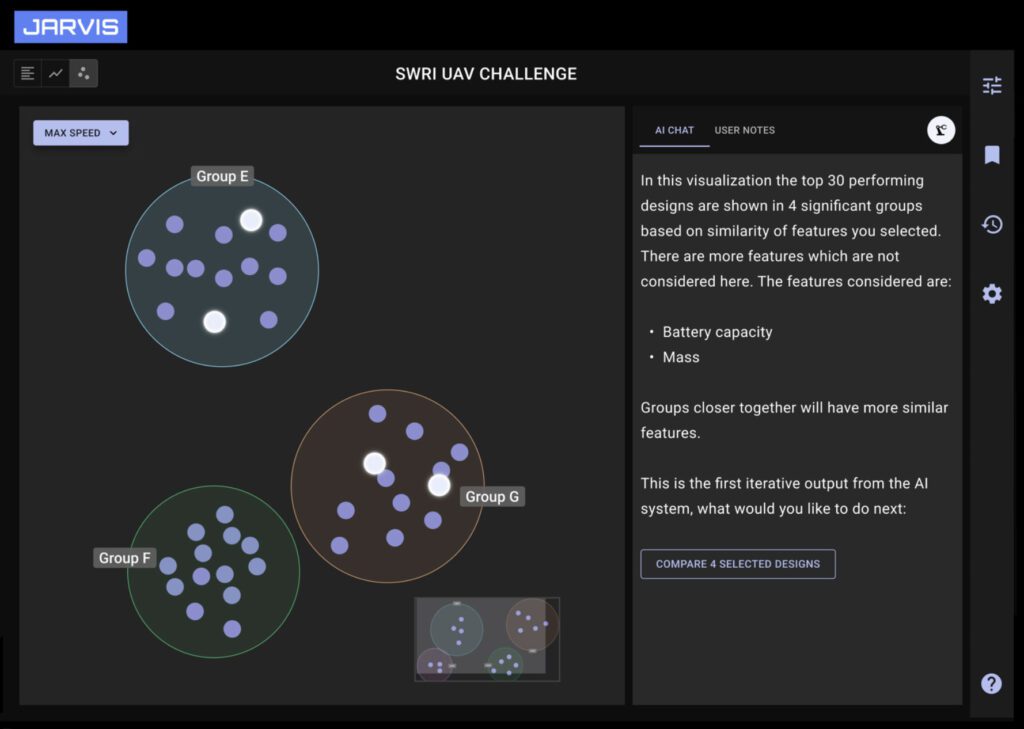JARVIS
AI enhanced design collaboration
for human creativity while mitigating bias
AI enhanced design collaboration for human creativity while mitigating bias
Joint, Adaptive, Robust Visualization and Interaction System (JARVIS)
As AI-based tools are increasingly incorporated into system design processes, human-machine collaborative workflows must mitigate potential biases of human designers while promoting human insights and creativity.
JARVIS supports an iterative process of design and evaluation by combining human users’ deep expertise and design intuition with a machine’s ability to explore and characterize vast search spaces to discover novel solutions to cyber-physical systems.

Tried-and-tested models are a proven entity, so using them as a starting point for new designs makes good business sense. However, such an approach skips looking for ideas in the space of the unexplored, and, as a result, we might be missing out on innovative designs that are cheaper and more effective than the ones we typically use.
Cyber-physical systems design is extremely complex, involving dozes of domains, and requiring subject matter expertise from designers and engineers across many disciplines. JARVIS enables designers to review and direct the activity of AI co-designers throughout the systems engineering lifecycle, providing critique and guiding design outcomes.
“What’s interesting about JARVIS is that we’re not just using AI to exhaustively explore a design space; we’re also creating tools that help engineering teams discover and understand promising—but possibly very unconventional—AI design outcomes, injecting their own unique expertise to seed and refine these designs as part of a collaborative human-machine process.”

Dr. Ryan Kilgore
Principal Scientist and Principal Investigator on JARVIS
Explore and iterate collaboratively with AI
JARVIS banks on a symbiosis between humans and AI to serve two functions. First, it helps system designers explore the space of the possible to find innovative new designs. Using the tool’s effective human-machine interface (HMI), designers can provide feedback to the AI to guide its exploration of the design space. Second, JARVIS helps designers refine specific components in new or existing designs to fine-tune each design’s ability to meet requirements. The tool provides a way for designers to interact with and understand the results of AI.
The advantage of using AI‑human symbiosis as the basis for the tool is that it harnesses the best of both. AI can churn through millions of design candidates and conduct early performance assessments to nudge designers toward new and potentially promising design directions. On the other hand, humans are good at understanding the limitations and practicality of the designs and using intuition to guide the design process. Working together enables wider and more optimized choices.
While traditional design follows a linear iterative path, JARVIS lets designers explore designs, then go back to previous designs and try different choices, and even merge great ideas from two streams of exploration. JARVIS enables optimization for any relevant parameter, whether that be material cost, speed and maneuverability of a vehicle, weight, or power consumption. The tool is agnostic to the specific domain of the design, so it is equally suited to exploring designs for air vehicles, underwater vehicles, or other systems.
Early use cases of JARVIS for DARPA explored the efficient “correct-by-construction” design of cyber-physical systems like aerial and underwater vehicles. In aerial vehicles, for example, JARVIS allowed design teams to explore what kinds of designs would deliver a sharper turning radius or faster acceleration. The correct-by-construction approach ensures that design candidates are put through their paces, so the final choice is sure to meet required criteria.


Because of its unique position as a tool that is focused on the designer’s experience, JARVIS has great commercial potential as a means to communicate useful feedback to AI tools. With JARVIS, AI‑human symbiosis can help achieve correct-by-construction designs that also value innovation.
“In this new era of AI-driven design, JARVIS makes sure that design engineers have the right tools to deliver creative, efficient, and cost-effective systems.”

Dave Koelle
Principal Software Engineer and Product Manager on JARVIS
Support existing innovation and workflows
JARVIS software development kit (SDK) can work with in-house data and/or AI and machine learning tools. JARVIS supports existing design workflows and helps designers optimize both simple designs and complex designs that involve multivariate parameters.
JARVIS was developed under the Symbiotic Design for Cyber Physical Systems (SDCPS) program. The goal of SDCPS is to enhance innovation in design through AI-based approaches that dramatically reduce the time from system inception to deployment (from years to months). JARVIS provides the bridge between that AI tech and human experts, and enables engineering teams to create highly performant, military-relevant cyber-physical systems on unprecedented timelines.
Contact us to learn more about JARVIS and our other capabilities in user interfaces and human-machine testing and artificial intelligence .
This material is based upon work supported by the United States Air Force and DARPA under Contract No. FA875020C0074. Any opinions, findings and conclusions or recommendations expressed in this material are those of the author(s) and do not necessarily reflect the views of the United States Air Force and DARPA.
